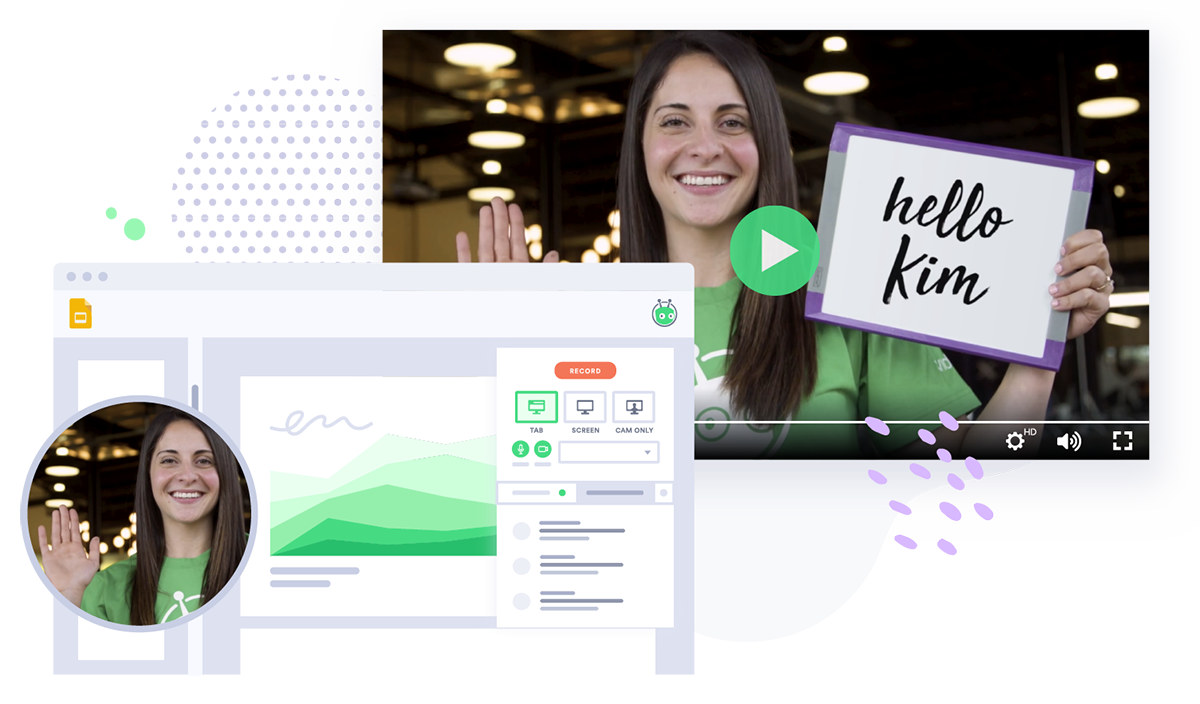Vidyard’s Ultimate Video Marketing Guide
Get started with video marketing! Learn how to develop your video strategy, make the right videos, and distribute and analyze your content to get the best results.
If you’re marketing your product or service, you need to be using video. After all, your competitors already are.
Video marketing is one of the best ways to promote your brand. When you’ve got the right plan of attack, video becomes your magic bullet for generating new leads, engaging prospective buyers, and driving more revenue.
In this video marketing guide, we’ll show you how to:
- Develop a video marketing strategy that works for you
- Use your videos to evoke emotion in your buyers
- Create the right types of videos
- Distribute your videos in the right places
- Optimize your videos for SEO
- Measure your videos’ results so you can point to their specific ROI
- Incorporate video marketing into your other marketing strategies
By the end of this guide, you’ll have the info you need to dive into video marketing with confidence. So let’s get started!
- Contents
- What’s Video Marketing?
- 9 Steps for Building Your Video Marketing Strategy
- Your Strongest Video Marketing Weapon: Video Storytelling
- Which Styles and Types of Marketing Videos to Create
- How to Host and Distribute Your Marketing Videos
- How to Optimize Your Marketing Videos for SEO
- How to Measure Video Marketing Analytics and ROI
- How to Use Video Marketing in Other Marketing Strategies
- You’ve Graduated the Video Marketing Crash Course!
What’s Video Marketing?
Video marketing (or sometimes “video content marketing”) is a digital strategy that leverages the power of video to attract, engage, and convert an audience into prospects or customers.
In plain terms: Your buyers love video. If you create video content for your brand, you can reach more people and convince more of them to buy your product or service.
Video can show off product features, tell brand stories, and build relationships with customers way more effectively than virtually any other medium.
Do you have a tentpole email nurture that just isn’t converting? Add a video to grab readers’ attention.
Do you have a key landing page with a huge bounce rate? Drop in a video to make visitors want to stick around.
Do you have an amazing customer success story? Turn it into a video that you can splash across social media.
Use cases like these are the reason why 96% of marketers say that video marketing is an important part of their strategy. Here are additional stats from Wyzowl sharing what marketers say about the results they get:
- 91% say it increases traffic.
- 95% say it increases brand awareness.
- 96% say it helps buyers better understand their offering.
- 90% say it generates leads.
- 87% say it increases sales.
- 92% say it gives them a good return on their investment.
And buyers love videos just as much as marketing teams do. 89% of buyers say that watching a video has convinced them to make a purchase. Plus, 91% want to see more videos from brands in 2023. So give them what they’re asking for!
9 Steps for Building Your Video Marketing Strategy
Yeah, you could just dive in and start creating videos right now. But you’ll get way more value out of your videos if you back them up with a strong video marketing strategy. When you have a set strategy, you’ll find that it guides and improves all your videos.
Don’t have a video marketing strategy? No problem! To build your own, come up with answers for these nine questions:
#1: What Are Your Video Marketing Goals?
Do you want to spread awareness? Boost email performance metrics? Drive more conversions? Break into new audiences?
Your specific goals will influence how you create and use your video content. As long as you keep your goals in mind, you’re better equipped to tackle nitty-gritty decisions about the videos you make.
Here’s an example: You know you’re making a video for social media to drive more traffic to your site. So you should make that video quick, punchy, and engaging to grab the attention of social scrollers. You should also pair that video with a clear CTA that drives back to your website.
#2: Who’s Your Target Audience?
How can you ensure your videos get seen by those who matter?
Different audiences watch your video content for different reasons. Think hard about your intended audience and exactly what that audience wants out of the videos you show them.
#3: What Kind of Videos Will You Make?
Depending on your goals and your audience, certain types of videos will work better than others. An audience of sales leaders might appreciate longer, more in-depth video content; a grab-bag social media audience will probably prefer something shorter and lighter.
#4: How Much Will You Spend on Creating and Distributing Videos?
Generally, a bigger budget makes for a better video. But if you don’t have the cash to throw around on a project, you can still make fantastic content; you just need to get a bit more creative.
How much budget can you devote to a video project? What can you do to maximize the effects of that budget (even if it’s $0)?
#5: Who’s Responsible for Making Videos?
Decide who’s in charge of video creation and their specific deliverables. Having a defined point of contact for your video content will let your team know who to turn to when they have questions or requests.
Here at Vidyard, we have a dedicated video production expert, plus we’re upskilling marketers all the time to become video creators. That clarity is especially important when your business is remote (like ours). It means less time sending Slack DMs and trying to track down who can answer your video queries.
#6: How Do Videos Fit into Your Other Marketing Campaigns?
We’re talking about your account-based marketing (ABM) strategy or demand generation tactics. (We’ll cover the specifics of using videos for these types of strategies later in this guide.)
#7: How Will You Host and Distribute Your Videos?
What platform will you use to host your video content? What specific features will that platform need to have?
And once it’s hosted, where will you share it? Will you embed videos on web pages? Include them in email blasts? Share them on social media?
#8: How Will You Measure Video Performance?
What success metrics are important to your team? Exactly how will you measure them?
(If you’re not sure, don’t panic. We’ll talk about video analytics and ROI measurement in a later section in this guide.)
#9: Who Else Will Use Your Videos?
Marketing isn’t the only team that can use video. Your sales, customer support, and experience teams (for instance) are all going to want different videos for different purposes, too.
Will your team be serving them? If they are, what’s the process for doing so?
Your Strongest Video Marketing Weapon: Video Storytelling
What’s the most impactful video you ever watched? No, we’re not talking about Gangnam Style (geez, remember that?)—we mean the heartfelt, memorable video that stuck with you long after you closed the window. It left a real impression…but why?
Here’s the secret. The key to a successful video is emotion. Emotion builds a connection between you and your viewer, and it makes your brand feel human and real.
So how do you evoke emotion? You tell a compelling story.
When you’re scripting your video, think back to the basic storytelling techniques you learned about in English class: Establish a character, present them with a conflict, and show the journey they take to resolve it.
Humanity has been telling stories this way for thousands of years. People can recognize the outline of a story on an almost unconscious level and use it as a way to keep information organized. For instance, what do you find easier to retain: A video that’s just a list of facts or a video that lists the same information in an interesting format of introduction-conflict-resolution?
“But the video I have in mind doesn’t have a character/conflict/journey!” Not to worry. Instead, try structuring your video this way: Present a problem, then the solution, then the results that the solution created. This format still tells a story but can be used even when you’re missing one of those traditional storytelling elements.
Remember that emotion = action. If you can make your audience feel something, your video will stick in their mind after it’s over. And if your video leaves that emotional impression, they’re much more likely to take that next step.
Here are a few more tips for video storytelling:
Delight Your Audience
Show your viewers something that they can get invested in. Tell a story about a loving family, a cute animal, or something else that makes your audience smile. If they have a positive association with your content, they’re more motivated to stay engaged.
Tell a Complete Story
Make sure your video’s story has a beginning, a middle, and an end. Your viewers should feel fulfilled by the story’s resolution. Don’t leave them hanging on the payoff unless you have a really good reason.
Show, Don’t Tell
You hear this all the time in creative writing class. Don’t rely on a narrator to describe how your central character is struggling with a problem: Show it! This is a video, after all. If you were just using words to tell your story, you’d write a blog post. (Hey, wait a minute…)
Think It Through
Creating a video takes time and effort. Don’t jump at your first promising idea; take your time in the planning stage to come up with a concept that really sings.
Tell One Story at a Time
Don’t try to stuff multiple stories into one video. Focus on a single story so viewers don’t get confused and distracted. Keep it short, snappy, and straightforward so they never lose the thread.
In this playlist of short documentary-style videos, Bandit Tour for Good does a great job of telling a visual story (and picking the right background music to match the vibe).

Which Styles and Types of Marketing Videos to Create
There’s a ton of different styles and types of videos to choose from.
A video style describes how you make the video. A video type describes what you make the video about.
Video Marketing Styles
Here are just a few video styles to consider:
- Live-action video (includes options like talking head, interviews, etc.)
- Animated video
- One-to-one video
- Screen share video
- Text overlay video
- Live streaming video
- 360-degree video
- Virtual reality video (VR video)
- Choose-your-own-adventure video
Video Marketing Types
Then there are the video types. Oh, the types! The full list is exhaustive, but there are nine key video types that every business should consider making:
- Explainer videos
- How-to videos
- Promo videos
- Thought leadership videos
- Webinars and recorded webinars
- Case study videos (a.k.a. customer stories or testimonial videos)
- Culture videos
- Demo videos
- FAQ Videos
Each video type serves a different purpose and fits in a different part of the marketing funnel. The most popular on-demand types for video marketing are product demo videos, explainers, and recorded webinars, according to our annual video benchmark data.
How Long Should Marketing Videos Be?
The answer changes depending on the video type.
Our video benchmarks have found that 66% of viewers watch a business video all the way through if it’s less than 60 seconds in length. Up to two minutes long, that drops to 56%. At 20 minutes or longer, it’s 22%.
In brief: The shorter, the better. As a rule of thumb, aim for under two minutes. (See our full guide on video lengths for a breakdown of the recommended runtime for each video type.)
How to Host and Distribute Your Marketing Videos
Video is everywhere. That means you can share it pretty much everywhere, too.
But before you can share them, you need to host your marketing videos first.
You’ve got a few options here. Lots of companies go the YouTube or Vimeo route. YouTube is especially easy and ubiquitous and should be used regardless to boost your organization’s SEO power. However, it can lack some of the more robust features you’d get in a video platform that’s designed for businesses instead of cat videos and reaction memes. So consider adding a proper hosting solution if you’re looking for better control of all your video content.
In our State of Video Report, we found that the top features that marketing teams care most about in a hosting solution are:
- Aggregate viewer analytics
- Video-sharing pages that match their brand
- Putting video on a website
- Integrations into CRM or marketing automation systems
- Individual viewer analytics
Once you have your video content hosted and built an appropriate video library, it’s time to distribute it. You can’t go wrong with your website when it comes to popular video distribution channels. But that’s far from your only choice.
The top favorite distribution channels for marketing teams’ are:
- Social media: LinkedIn, Facebook, Instagram, Twitter, TikTok, Snapchat, and more
- Websites
- Sales and customer conversations
- YouTube
Other distribution options include:

 Know where you stand, so you can stand out. Get the insights you need to craft a video strategy that works. Read the Report
Know where you stand, so you can stand out. Get the insights you need to craft a video strategy that works. Read the Report How to Optimize Your Marketing Videos for SEO
If you want your site to get discovered in search, video is a big part of the equation.
Google increasingly includes videos in search results—even when searches don’t explicitly request video. When videos do appear in the main results (and not just on the “Videos” tab), they tend to sit near the top of the page. And Google can even search inside your videos to find the result searchers are looking for.
Having (the right) video content increases your chances of appearing high on search engine results pages (SERPs). Here’s how to create the right guideposts to help your videos increase traffic.
- Add the right metadata. Make sure to include a title that features keywords, a useful description, relevant tags, and surrounding text. For best results, also include a transcript and video chapters. And remember: Always avoid duplicate copy or metadata!
- Host in the right place. Hosting the video on your site helps keep that SEO juice in-house, but you might not see huge results in SERPs. If you host it elsewhere (like YouTube) and embed it on your site, your video can climb higher in SERPs…but your website as a whole might lose out on some of that overall SEO value.
- Use a high-quality thumbnail. Attach a thumbnail that grabs attention. (Hint: We’ve found that including a person—especially one who’s smiling—makes your thumbnail more likely to be clicked.)
- Follow Google’s recommendations. Refer to Google’s video SEO best practices for guidance on web hosting techniques that make your video more discoverable.
How to Measure Video Marketing Analytics and ROI
Marketing teams need to produce tangible results, and video marketing is no exception. If you’re not tracking the performance of your video content—and learning from it to improve your future campaigns—you’re getting left behind.
Video data can provide a lot of insight. With other assets, like reports or ebooks, you can only really analyze if someone downloaded or read it—not how much they read. (That would be nice, right?)
That’s not the case with video. If you’re using the right video analytics platform, you can pull detailed information about how viewers engage with your video. It’s not just view counts: It’s also how much of the video they watched, what parts they skipped, and whether they engaged with the calls to action (CTAs) you included inside the video. According to our benchmarks, the average CTR on a video CTA is 3.21%. We’ve seen that jump as high as 30% on our own content if the CTA is super relevant to the video content.
Here are a few video marketing metrics we recommend you keep tabs on:
- Overall view count
- Click-through rate
- Attention span data
- CTA engagement rate
And when you integrate your video platform of choice into your marketing automation tool or CRM, you can step it up even further. You can connect view data to specific contacts, build custom dashboards and reports, see how video views contribute to sales pipeline, and lots more.
Hot Tip: Just like with any marketing initiative, your boss wants to see the value of video marketing. Once you’ve got video analytics data in hand, try using it to set specific goals that play into your team’s KPIs and your company’s overall strategy.
How to Use Video Marketing in Other Marketing Strategies
Video marketing fits seamlessly with your other marketing plays, too. Below, we’ll cover how you can slot your marketing videos into your demand generation activities and your ABM programs.
Video Marketing for Demand Generation
Video can do a lot more than just attract eyeballs. It can also engage and convert leads—making it a powerful addition to your demand generation strategy.
Here are a few ideas for putting it to work:
- Add video to your homepage, product pages, and landing pages to capture attention and drive action.
- Leverage in-video forms to generate leads.
- Use in-video CTAs to drive viewers to valuable activities and other conversion points.
- Gate high-value video content (like webinars) to capture leads.
- Nurture potential customers with engaging video email marketing.
And that’s not all. Remember how we walked about connecting your video hosting platform to your marketing automation or CRM systems in the previous section? That’s useful here, too. You can automatically factor video view data into your lead qualification and scoring programs.
Video Marketing for ABM
Great ABM programs thrive on effective targeting and personalization. Video marketing can help with both.
It’s estimated that office workers receive 121 emails every day—and that was back in 2015. Can you even imagine how many more they must get now?
Help your ABM campaign cut through all that noise by sending either a one-to-one personalized video to people at your account or an account-based personalized video. People are more likely to engage with a video than they are with a text-based email—and who doesn’t love a little message that’s clearly been made just for you?
Focus on sharing video content customized to your account’s industry, geography, or even specific organization. Target it as tightly as you can!
There are all kinds of attention-grabbing ways to get your video in front of your target account. Here are a few ideas:
- Send it through an email marketing nurture.
- Run targeted ads for individuals within the account, and when they click, send them to a video content hub that’s customized for them.
- Send a video greeting card—a physical card that contains a digital screen with a pre-loaded video—straight to their door.
Don’t Forget About Account-Based Selling
Even the best ABM tactics and programs won’t get you very far if your sales team isn’t on board.
Tag your sales team to coordinate their outreach while you’re targeting accounts with marketing content. Get your sales reps to record their personal, one-to-one videos to engage members of the target account in conversations.
Your pals in sales can also benefit from the insights you’re gleaning from video performance. You can pass off video engagement data to help sales reps prioritize their activities, like hitting the hot leads minutes after they engage with your marketing videos. Talk about fast follow-up!
You’ve Graduated the Video Marketing Crash Course!
Video marketing can do a lot for your business—if you use it right. When you approach it with a strong strategy and take the time to apply best practices, video can have a massive impact on the success of your marketing and go-to-market teams.
Congrats! You now know everything you need to get started. Good luck!
This post was originally published on October 27, 2019. It was updated on July 14, 2023.




